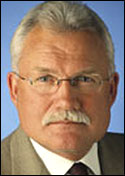Mic Dinsmore, CEO of the Port of Seattle, says that more work needs to be done in 2005 by both the private and public sectors to secure the global supply chain. He did not spell out exactly what technologies they should use but said that any system deployed would likely use RFID as part of a real-time network to track containers and share information.
“The good news is that three years and three months after 9 /11, we haven’t had any more terrorist incidents,” Dinsmore said, speaking at the National Cargo Security Council’s RFID Seminar in Long Beach, Calif., this week. “The bad news is we still don’t have an integrated network that adds value, is affordable, that companies buy into it and makes trade more secure.”
Dinsmore says the Port of Seattle, a municipal corporation that manages the Seattle seaport, was shaken financially by the Sept. 11 terrorist attacks because business declined and the cost of operation soared because of the need for greater security. He said the port has done a good job of implementing security features at its facility. The problem is there is little sharing of data about the goods coming into the port.
The port has been involved in Operation Safe Commerce, a program funded by the U.S. Department of Transportation and the U.S Customs to test the potential of technologies to secure the supply chain, as well as Smart and Secure Trade Lanes (SST), a private-sector initiative (see Safeguarding Shipping Profitably).
Dinsmore said that the port recently signed a memorandum of understanding with ports in Hong Kong, China, Japan and South Korea to work together to seek collaborative solutions to the security issue. He could not say which technologies would be involved, but said active RFID tags would likely be a part of the solution.
Active tags can be used to uniquely identify containers. The tags can store information about the contents of a container, and electronic RFID seals can be used to make sure a container isn’t opened without authorization while in transit.
Dinsmore said that the Port of Seattle has been testing the technology as part of larger efforts that to try to bring users together, so the industry can learn what technology and systems are needed to develop a national system that can be implemented. But he said it is essential that the industry not go through another year of testing, and that it is time to start implementing a system.
“Even if we develop a system that is 80 percent effective, that’s better than what we have today,” Dinsmore said. “We need to start implementing a system next year. It’s not just about safety and security but also about value-added. ”
He explained that Target, Wal-Mart and Starbucks are looking to RFID to help them run their business better, and any security system should work with supply chain tracking systems being developed by these early adopters. “We need to align the safety and security component with the part of a [supply chain] system that will add value,” he said.
“It’s important that 2005 doesn’t come and go and all we’ve done is more testing,” he said. “The only way I’m going to sleep well is to implement something.”
Dinsmore said given the open nature of democratic societies, the system could not offer 100 percent security. But he said industry and government could be doing a lot more to secure international trade by having a global network to track containers through the supply chain.


